Car detailing includes multiple steps, designed to clean, protect, and enhance the appearance of your precious ride. It’s a process that involves cleaning and treating multiple components, each of them made from different materials, and requiring specific steps and detailing products.
One of the most important components of any car, truck, or SUV is the tires – that help the vehicle start and stop safely. While tire maintenance includes frequent air pressure checks, proper rotations, and replacement – keeping the sidewalls clean, looking sharp and protected from exposure to UV rays, road grime, and contaminants is just as crucial.
To accomplish this task, many car owners use tire dressing or shine products that produce a high gloss finish. But what is tire dressing, what’s it made from, and what is it designed to accomplish – besides enhancing the shine?
Do you need a tire dressing applicator, a shine spray, or can you use homemade tire shine products to clean your car tires? This is what we’ll attempt to undercover in today’s AvalonKing blog.
What is Tire Dressing?
Tire dressing is a chemical formula that is intended to restore black rubber that has faded over time. It’s applied to vehicle tires after they have been washed to remove dirt and grime(but not with dish soap), which delivers a deep, rich, and high gloss or dark appearance of the tire.
There are generally three different types of tire dressing groups – dressings, waxes, and sealants. The dressing group is made from water-borne or solvent based and silicone based materials, that are combined with oils that help to penetrate the rubber and restore the product. Basically, it serves as a lubricant to rehydrate dried-out rubber – which is a leading source of fading.
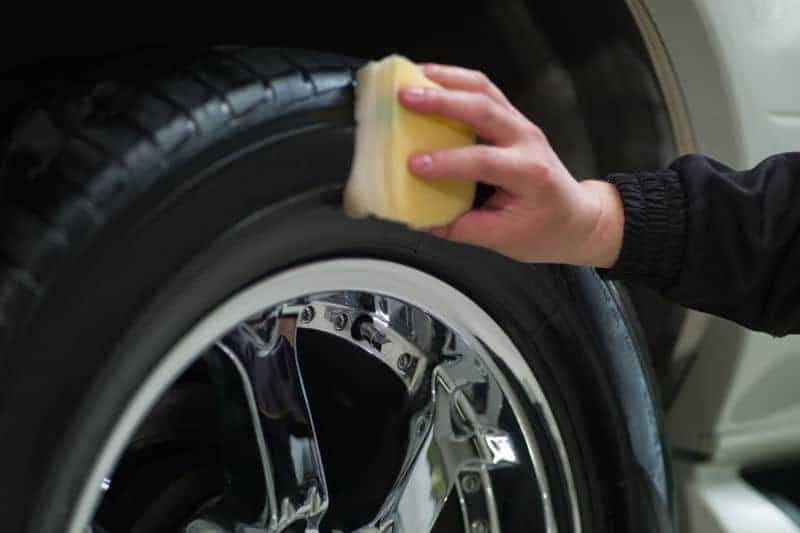
Wax-based are long lasting tire dressing products that are basically designed like shoe polish. You apply it to the tire, leave it on the sidewall of the tire for a bit, then wipe or buff it off. The sealant type of tire dressing is synthetic in nature, that provides a layer of protection on top of the tire.
Within these three groups of tire dressing, there are those that are matte, satin, or glossy. Long lasting tire gloss products do not act as an all-purpose cleaner. They are not made to remove dirt, brake dust, or replace your routine car wash. They can help to provide UV protection for the tire sidewall surface and keep them shiny.
Comparing Water vs Solvent Tire Dressings
Most DIYers will use water or solvent-based tire dressing to provide a shine on tires. The main difference between the two is the carrier system that is used. Solvent-based tire dressings use a hydrocarbon silicone that suspends the dressing, while the water-based solution is typically a milky-white colored liquid that provides a satin-like appearance. Either can use an applicator pad to make it easier than using a spray can.
The solvent-based product is intended to leave a wet-appearance. They are sticky liquids, often clear in appearance, and contain petroleum solvents. While they make the tire look great, they can lead to premature cracking or drying of the sidewall. This can be a safety hazard, as it’s possible for tires to pop if the sidewall is cracked.
What are the Pros and Cons of Tire Dressing Products?
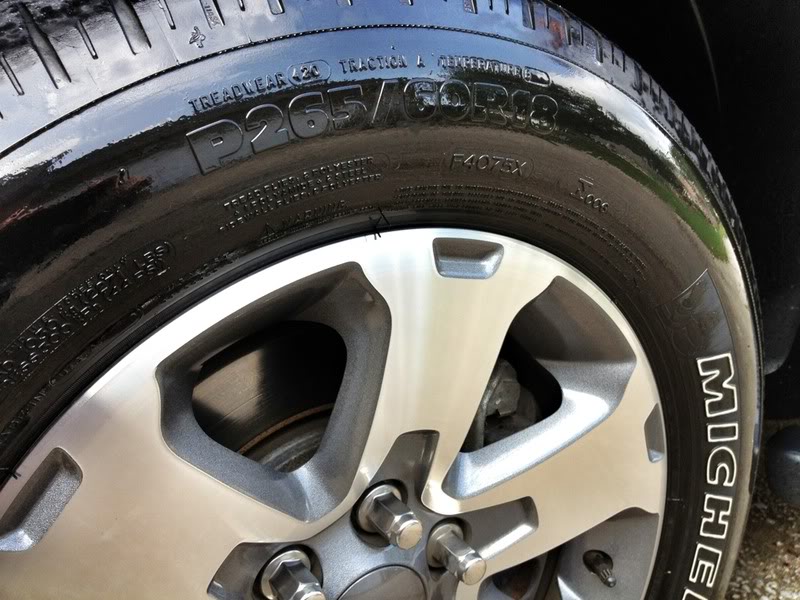
The water-based tire dressing is much more environmentally friendly. However, there are some pros and cons that you should consider before deciding to use these products.
Pros
- They can help to prevent fading, cracking, and hardening of tire sidewalls.
- It helps to revitalize the condition of the rubber.
- It can be used as an aerosol or spray bottle – making it easy to apply.
- Biodegradable and environmentally conscious (the water-based products).
Cons
- Solvent-based tire dressings can easily sling onto your paint, as they remain ‘wet’.
- Petroleum distillates in these formulas can also harm the tire, expediting cracking.
- Applying aerosol tire dressings can easily spray onto brake rotors – leading to premature brake failure.
- Should not be used on motorcycle tires – EVER!
How to Apply Tire Dressing Correctly
Obviously, there are multiple types, brands, and application methods for tire dressings. This means, there isn’t a single, universal best practice for applying these products to your tires. However, the general rule of thumb is to always follow the specific directions of each product you purchase and use.
A big mistake that several car owners make is using a spray or aerosol tire shine product. These contain chemical agents – mainly alcohols that dry the rubber – as opposed to treating or hydrating them. So, if I were to offer a single piece of advice, it would be to avoid aerosol tire dressing products like the plague.
Here are a few other tips for using tire dressing and tire shine products on your valuable rides.
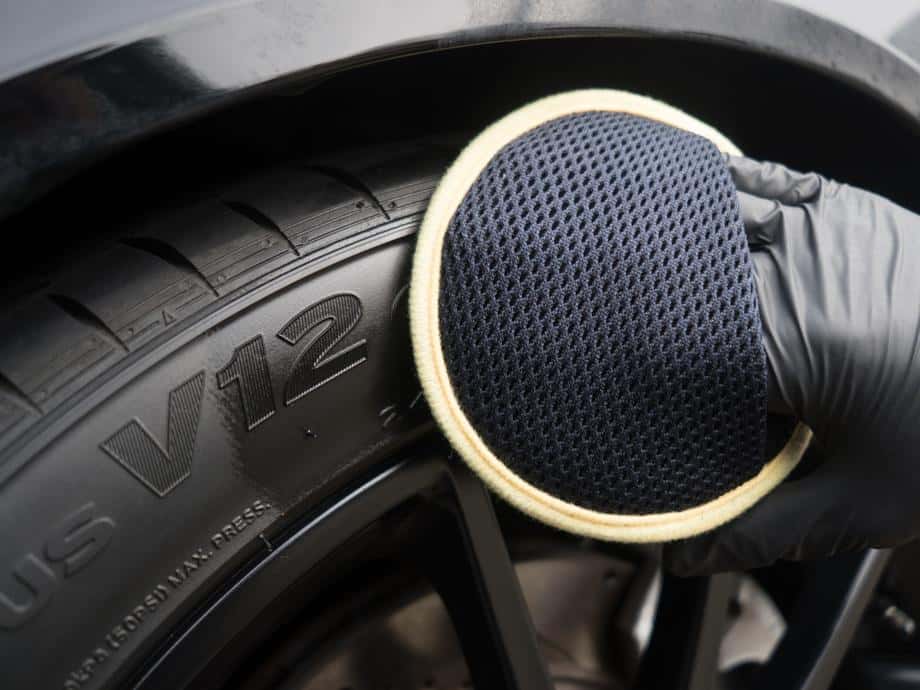
Use foam applicators. If you have a spray-on tire shine product, spray it on a microfiber or terry towel first, then apply it onto the sidewall of your tires. This will provide an even application of the tire shine, and help to avoid accidental exposure to brake rotors, discs, and pads.
Don’t leave the dressing ‘wet’. While this makes your tires look like a freshly waxed or as deep as your ceramic coating protected paint, it can cause a lot of headaches. As soon as you start driving, that ‘wet stuff’ is going to fling off the tire and onto your paint job. Instead of leaving it wet – use a fresh microfiber towel to lightly wipe the ‘wet stuff’ off the tire sidewall.
Never apply to the tire tread. While it’s ok to apply a tire dressing to the entire sidewall, you don’t want to apply it on your tire footprint. As soon as you start driving, you’ll significantly reduce traction, which can lead to an accident.
Take your time. It’s also common for car owners to rush with applying tire dressing. This can lead to messy applications, especially finding a home on your wheels. If you’ve got polished aluminum, mag, or chrome wheels, tire dressings will smear, and make them look like crap. So, take your time and be thorough.

Make it your final step. If you’re detailing your car, spend time wrapping up the project by applying the tire dressing and polishing those wheels. In most cases, when you’re washing the vehicle, the tires and wheels should be your first step. With detailing, that should be the last thing you touch. Also, use some sort of applicator, either a microfiber applicator or a terry towel.
Other Tire Care Tips to Consider

Tire dressings are great for restoring those faded tires to a clean shine. Make no mistake – a tire dressing is just a cosmetic enhancement. It does not fix tires that are cracked, dry-rotted, or have imperfections or sidewall damage.
However, there are some things you should keep in mind – with the way you care for your tires. And the best way to explain it – is on an acronym I’ve used for years – T.I.R.E.
Keep them TIDY

The first way to keep your tires in great shape is to keep them clean and tidy. I firmly believe this is best accomplished by simply washing your wheels and tires every two weeks – or anytime you’re frequently driving in snow or icy road conditions.
Applying tire shine or dressings can help to protect the sidewall of the tire from exposure to contaminants, but it only lasts a few days. This is why it’s best to keep them clean frequently. Just don’t leave road grime and crud on the tires for extended periods.
INSPECT them Monthly
Did you know that when your temperature rises or drops 10 degrees, the PSI on your tire will likewise increase or decrease by one? This is quite true – and a major source of premature tire wear; especially when the temperature range is extreme. To avoid this common problem, its best to inspect your tires once per month.
A good tire inspection includes checking the tire pressure, adjusting to the manufacturer’s recommended PSI (when the tires are cold, and you haven’t been driving for the day). You should also inspect the sidewall of your tires for any cracking, slices in the rubber, bubbles, or other signs of damage. Final inspection includes reviewing the inner and outer tread – for signs of uneven tire wear.
ROTATE and REPLACE
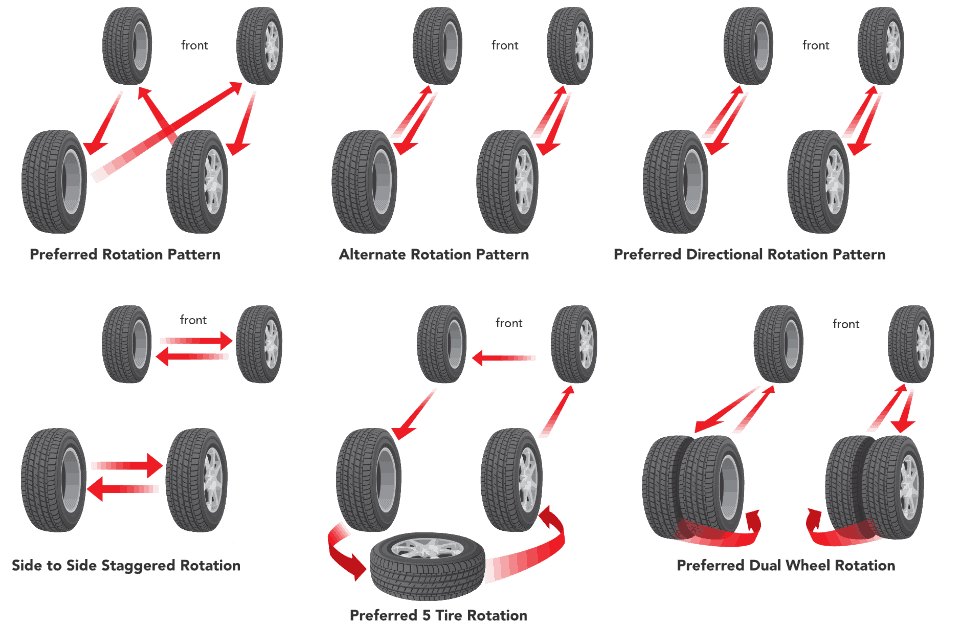
It is recommended by a tire and automotive manufacturers to rotate your tires every 5,000 miles. However, if you’ve got a performance vehicle, that has two different tire sizes or directional tires, this can be a challenge.
If this is your situation, make sure to replace the tires when they approach 2/32nds of an inch of tread depth. Tires should also be replaced anytime you have sidewall damage, exposed radial belts, or they are overly dry. Any tires rated higher than “H” in the performance area, should be replaced within 5 years of the DOT date code.
Take it EASY on Loads
Each tire is also designed to keep a certain load range (of weight over each tire – and spread across the entire vehicle). If you overload your vehicle, the tire will develop excessive heat, and likely lead to tire failure. At higher speeds, this can be a deadly situation – so always take it easy with your ratings. This also applies to maximum speed, doing burnouts, and aggressive handling.
Wrapping it Up
When you’re thinking about using a tire shine or tire dressing product, make sure it does not contain alcohols, or any agents that will lead to drying, cracking, or any sidewall damage. There are several high-quality products on the market, but there are also some cheap versions as well.
And while there might be some DIY tire dressing formulas out there, made from lemon oil, castor oil, and other household stuff that makes your tire wet, don’t be tempted by the quick and easy path. Always use good dressing products to protect your vehicle’s shoes.






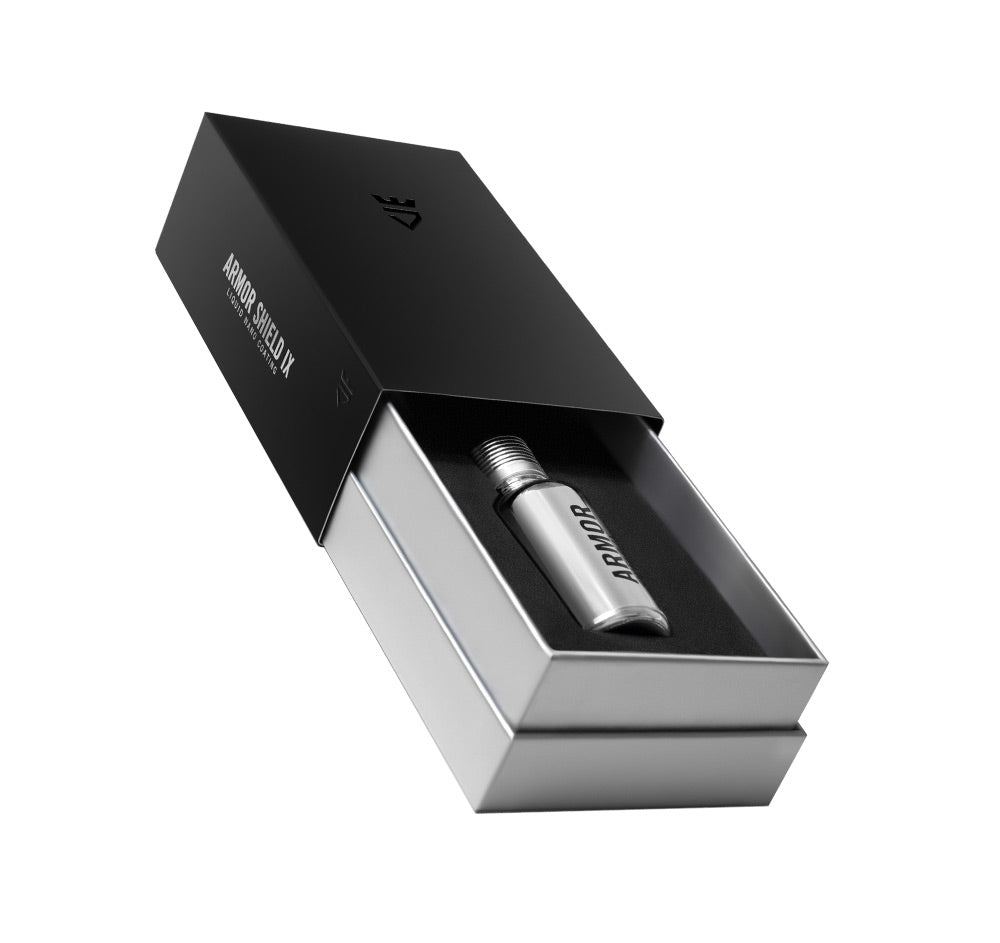



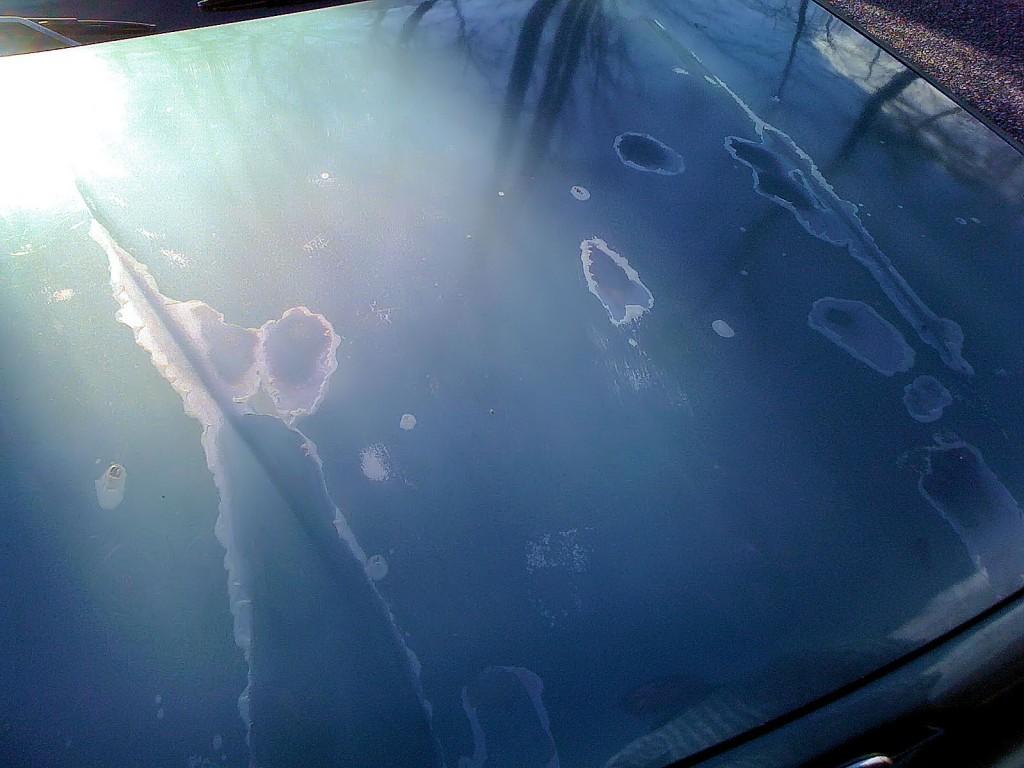


3 comments
Jason King
This doesn’t mention the foam products. The foam is a “spray and walk away” type product. You have to spray it on the tire itself, as you can’t spray it on to a sponge or other wiping product. Do they make water and solvent based foam products?
This doesn’t mention the foam products. The foam is a “spray and walk away” type product. You have to spray it on the tire itself, as you can’t spray it on to a sponge or other wiping product. Do they make water and solvent based foam products?
Oliver
I do the tires and wheels last, thereby not wasting car washing products.
The economical thing to do.
I do the tires and wheels last, thereby not wasting car washing products.
The economical thing to do.
Horace Moning
Hi I want high gloss shine if I can find it.
Hi I want high gloss shine if I can find it.